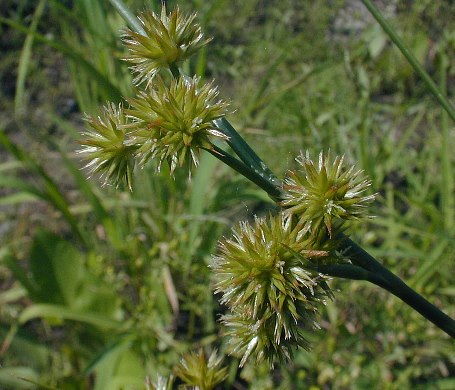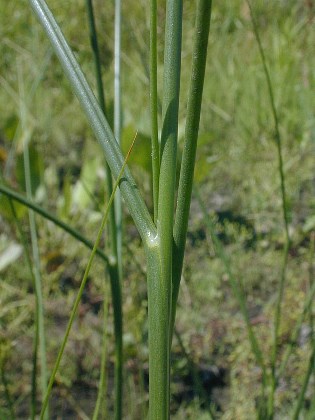Description: This perennial rush is 2-3' tall and unbranched, except near the apex where the inflorescence occurs. The stout central stem is green, glabrous, and terete (round in cross-section). There are 2-5 alternate leaves along each stem. The blades of these leaves are up to 12" long and nearly ¼" across; they are green, glabrous, terete, and stiff. The blades are ascending to widely spreading and they often extend beyond the inflorescence. Along the upper surface of each blade, there is a narrow shallow channel. There is a sheath at the base of each leaf blade. The apex of this sheath is translucent-membranous while it is young; later this area becomes dried and brown. The central stem terminates in a compact panicle of flowerheads spanning up to 3½" tall and/or across (rarely larger). There are usually 3-20 flowerheads per panicle; however, some unusual specimens can produce as few as one flowerhead or as many as 50 flowerheads per panicle.

During the summer,
these flowerheads are usually yellowish to reddish green and shiny;
during the fall, they become brown and dull. Each mature flowerhead is
globoid in shape and spans about ½" across; however, an immature
flowerhead is only partially globoid and a little smaller in size. Each
flowerhead consists of a dense cluster of 25-100 florets. Each floret
has 3 bract-like sepals, 3 bract-like petals, 6 stamens, and a narrow
ovary that later becomes a seed capsule. The sepals and petals are
linear-lanceolate and about 4-5 mm. long. The ovaries/capsules are
narrowly ellipsoid with long beaks; they are about 5 mm. long. Because
of their pointed sepals, petals, and ovaries/capsules, the flowerheads
are bristly in appearance. The blooming period occurs during mid- to
late summer. The bisexual florets of each head are wind-pollinated.
Each seed capsule contains numerous tiny seeds that can float on water
or blow about in the wind. Each seed is 0.5 mm. long or less; it is
ellipsoid, pale brown, and slightly pointed at both ends. The root
system is rhizomatous and fibrous. The rhizomes become tuberous at
intervals; this is where vegetative offshoots develop. Occasionally,
rather loose colonies of plants are formed from such offshoots.
Cultivation:
The preference is full sun, consistently moist to periodically wet
conditions, and soil that is slightly acid to alkaline. The soil can
consist of mud, sand, or poorly drained clay. This rush can spread
aggressively in disturbed wetlands where there is little competition.
Range & Habitat:
The native Torrey's Rush is common in most areas of Illinois (see Distribution
Map). Habitats include wet prairies, prairie swales, sloughs,
borders of ponds and streams, and roadside ditches. This species
tolerates some degradation of wetland habitat.
Faunal Associations:
Insects that feed on Juncus spp. (Rushes) include Plateumaris
pusilla (Leaf Beetle sp.), the larvae of Archanara
subflava (Subflava Sedge Borer Moth), and the larvae of Eutumostethus
luteiventris (Sawfly sp.). It is possible that that the seeds
and seedheads of this and
other Rushes are eaten by various wetland birds and songbirds; if so,
their value as a food source appears to be minor. In conjunction with
other wetland plants, Torrey's Rush provides cover for wildlife. Ducks,
geese, and other waterfowl may help to distribute this rush to new
wetlands because the tiny seeds can cling to their feathers or muddy
feet. Mammals may assume a similar role in seed distribution.
Photographic Location:
A roadside ditch in Urbana, Illinois.
Comments:
The large globoid seedheads (about ½" across) help to distinguish
Torrey's Rush from many other Juncus spp. (Rushes).
In particular, the seed capsules are unusually long and pointed. This
species is somewhat variable across its range with respect to the
number of seedheads that are produced per plant and the size of those
seedheads. A similar species, Juncus nodosus, is
largely restricted to NE Illinois. It has smaller seedheads (about 1/3"
across) that contain fewer florets (about 10-25). Like Torrey's Rush,
this species has seed capsules that are slender and pointed. Another
species, Juncus brachycarpus, also has globoid
seedheads (about 1/3" across). However, its seed capsules are obovoid
and blunt-topped, and they are shorter than their sepals. Finally, Juncus
scirpoides also has globoid seedheads (about ½" across). Like
Torrey's Rush, this latter species has seed capsules that are slender
and pointed (about 4-5 mm. in length), but its sepals and petals are
shorter (about 3 mm. in length). While Torrey's Rush and Juncus
nodosus have 6 stamens per floret, Juncus
brachycarpus and Juncus scirpoides have
only 3 stamens per floret.